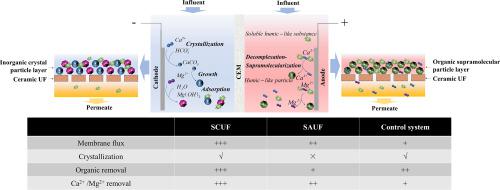Desalination ( IF 9.9 ) Pub Date : 2021-07-16 , DOI: 10.1016/j.desal.2021.115243 Jinlong Wang 1 , Xiaobin Tang 1 , Xiaoxiang Cheng 2 , Jiajian Xing 3 , Hesong Wang 1 , Guibai Li 1 , Heng Liang 1

|
Ceramic ultrafiltration (UF) is promising in treating the nanofiltration (NF) concentrate, however, the ceramic UF membrane suffers from severe fouling with inefficient softening. To address such issues, a cation exchange membrane (CEM) electrolysis method was proposed for ceramic UF fouling control by enhancing pH variation, forming the separated-cathode/UF (SCUF) and separated-anode/UF (SAUF), and conventional electrolysis without CEM/UF (control system) was also investigated. The results showed that all electrolysis strategies contributed to UF fouling alleviation; specifically, the separated-cathode outperformed separated-anode. In SCUF process, particles were produced due to the crystallization of calcite and amorphous magnesium hydroxide. Prolonging the electrolysis to 90 min, the inorganic particles accumulated on the membrane surface could be increased to 42.3 gCa/m2 and 11.8 gMg/m2, effectively softening the NF concentrate. Furthermore, the freshly generated particles effectively adsorbed organic foulants, achieving organic removal improvement by 44%. Interestingly, the crystal particles accumulated on the membrane surface, providing a dynamic barrier to avert the migration of organic matter onto the membrane surface. In addition, humic-like substances were transformed into supramolecular organic particles and rejected by the UF membrane under low pH conditions during the SAUF process. These findings would provide practical relevance for the advanced treatment of NF concentrates.
中文翻译:

CEM电解原位结晶使NF浓缩液软化并减轻陶瓷膜污染
陶瓷超滤(UF)在处理纳滤(NF)浓缩液方面很有前景,但陶瓷超滤膜严重污染,软化效率低。为了解决这些问题,提出了一种阳离子交换膜(CEM)电解方法,通过增强 pH 值变化,形成分离阴极/超滤(SCUF)和分离阳极/超滤(SAUF),以及不使用传统电解法来控制陶瓷超滤结垢。还研究了 CEM/UF(控制系统)。结果表明,所有电解策略都有助于减少超滤污染;具体而言,分离阴极优于分离阳极。在 SCUF 过程中,由于方解石和无定形氢氧化镁结晶而产生颗粒。将电解时间延长至 90 分钟,2和 11.8 gMg/m 2,有效软化 NF 浓缩物。此外,新生成的颗粒有效地吸附了有机污染物,有机物去除率提高了 44%。有趣的是,晶体颗粒积聚在膜表面,提供了一个动态屏障,以防止有机物迁移到膜表面。此外,在 SAUF 过程中,腐殖质类物质被转化为超分子有机颗粒,并在低 pH 条件下被 UF 膜排斥。这些发现将为 NF 浓缩物的高级处理提供实际相关性。



























 京公网安备 11010802027423号
京公网安备 11010802027423号